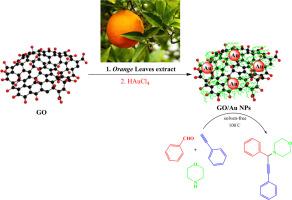Bio-decorated gold nanoparticles over the surface of graphene oxide mediated by Orange leaves extract as efficient catalyst for synthesis of propargylamines and evaluation of its antioxidant activity
IF 2.1
3区 化学
Q3 CHEMISTRY, INORGANIC & NUCLEAR
引用次数: 0
Abstract
A novel and eco-friendly approach for creating gold nanoparticles (Au NPs) integrated with graphene oxide modified by Orange leaves extract has been introduced. The phytoconstituents found in Orange leaves extract, owing to the presence of polyhydroxyl groups, aided in the green reduction of gold ions on the graphene oxide surface, resulting in the formation of the GO/AuNPs nanocomposite. The produced nanocomposite underwent characterization through FE-SEM, EDX, elemental mapping, ICP, and TEM analysis. TEM imaging illustrated that the gold nanoparticles displayed a spherical shape, were mono-dispersed, and had an approximate diameter of 10–20 nm. The GO/Au NPs' catalytic efficiency was evaluated in a three-component reaction combining amines, alkynes, and aldehydes (A3 coupling) to produce derivatives of propargylamines. After being recovered by centrifugation, the GO/Au NPs catalyst showed enough stability to be used again for seven consecutive cycles with negligible activity loss. Additionally, by evaluating the antioxidant effects of the GO/Au NPs, their biological properties were investigated. DPPH radical scavenging experiments were used to assess antioxidant activity, and the IC50 value was found to be 97.6 µg/mL.

橙叶提取物介导氧化石墨烯表面生物修饰金纳米颗粒合成丙胺的高效催化剂及其抗氧化活性评价
介绍了一种新型的、环保的制备金纳米粒子(Au NPs)的方法,该方法与橙叶提取物修饰的氧化石墨烯相结合。在橙叶提取物中发现的植物成分,由于多羟基的存在,有助于氧化石墨烯表面金离子的绿色还原,从而形成氧化石墨烯/AuNPs纳米复合材料。制备的纳米复合材料通过FE-SEM, EDX,元素映射,ICP和TEM分析进行了表征。TEM成像表明,金纳米颗粒呈球形,单分散,直径约为10-20 nm。在胺、炔和醛(A3偶联)合成丙胺衍生物的三组分反应中,对氧化石墨烯/Au NPs的催化效率进行了评价。经离心回收后,GO/Au NPs催化剂表现出足够的稳定性,可以连续使用7个循环,活性损失可以忽略不计。此外,通过评价氧化石墨烯/金纳米粒子的抗氧化作用,研究了它们的生物学特性。通过DPPH自由基清除实验评估其抗氧化活性,IC50值为97.6µg/mL。
本文章由计算机程序翻译,如有差异,请以英文原文为准。
求助全文
约1分钟内获得全文
求助全文
来源期刊

Journal of Organometallic Chemistry
化学-无机化学与核化学
CiteScore
4.40
自引率
8.70%
发文量
221
审稿时长
36 days
期刊介绍:
The Journal of Organometallic Chemistry targets original papers dealing with theoretical aspects, structural chemistry, synthesis, physical and chemical properties (including reaction mechanisms), and practical applications of organometallic compounds.
Organometallic compounds are defined as compounds that contain metal - carbon bonds. The term metal includes all alkali and alkaline earth metals, all transition metals and the lanthanides and actinides in the Periodic Table. Metalloids including the elements in Group 13 and the heavier members of the Groups 14 - 16 are also included. The term chemistry includes syntheses, characterizations and reaction chemistry of all such compounds. Research reports based on use of organometallic complexes in bioorganometallic chemistry, medicine, material sciences, homogeneous catalysis and energy conversion are also welcome.
The scope of the journal has been enlarged to encompass important research on organometallic complexes in bioorganometallic chemistry and material sciences, and of heavier main group elements in organometallic chemistry. The journal also publishes review articles, short communications and notes.
 求助内容:
求助内容: 应助结果提醒方式:
应助结果提醒方式:


